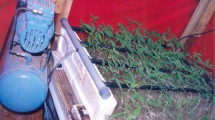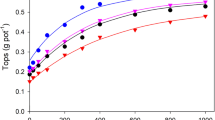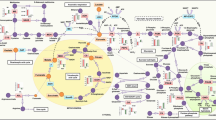Summary
The relative yield response and phosphate uptake ofS. humilis, P. atropurpureus andD. intortum, grown on a very deficient soil, enriched with phosphate, were measured at four successive harvests during 42 days growth under controlled environmental conditions. Except at the first harvest (19–21 days), the relative yields ofS. humilis andP. atropurpureus at P0 were identical, and slightly greater than that ofD. intortum; the relative response to applied phosphate was similar for the three species, up to the maximum yield attained. The higher relative yield ofD. intortum, at harvest 1, reflected the influence of a higher initial phosphate concentration in the small Desmodium seedling, compared toS. humilis andP. atropurpureus.
The mean absorption rate for phosphate\(\overline {\left( {AR} \right)} \) ofD. intortum, and to a lesser degreeS. humilis andP. atropurpureus, showed two distinct maxima: an initial peak at low soil activities (0.3 — 3µM P), and a second at higher soil activities (37–43µM P) when maximum yield had been attained, and luxury accumulation of phosphate appear to occur. The initial peak in\(\overline {AR} \) was followed by a decline (significant (P=0.05) forD. intortum) at soil phosphate activities corresponding to maximum yield, suggesting that the rate of absorption by the roots was influenced by the demand for phosphate created within the growing plant.
Mean absorption rates and relative growth rates\(\overline {\left( {RGR} \right)} \), averaged over all phosphate levels, fell in the orderD. intortum >S. humilis >P. atropurpureus. Conversely, the efficiency of phosphate utilization by the plant, which may be expected to be greater in plants of low RGR, fell in the orderP. atropurpureus >S. humilis >D. intortum, and so counteracted the lower\(\overline {AR} \) ofP. atropurpureus, and to a lesser extent,S. humilis. However,S. humilis had the advantage of a lower retention of phosphate in the root system, compared toP. atropurpureus, due to a relatively greater shortage of nitrogen in the tops when grown on symbiotically-fixed nitrogen.
Similar content being viewed by others
References
Andrew, C. S., A kinetic study of phosphate absorption by exised roots ofStylosanthes humilis, Phaseolus lathyroides, Desmodium uncinatum, Medicago sativa, andHordeum vulgare. Australian J. Agr. Research17, 611–24 (1966).
Beckett, P. H. T., and White, R. E., Studies on the phosphate potentials of soil. III. The pool of labile inorganic phosphate. Plant and Soil21, 253–82 (1964).
Bradshaw, A. D., Ecological Aspects of the Mineral Nutrition of Plants. Blackwell Scientific Publications, Oxford (1969).
Clapham, A. R., Ecological aspects of the mineral nutrition of plants, Blackwell Scientific Publications, Oxford (1969).
Clarkson, D. T., Phosphorus supply and growth rate in species of Agrostis L. J. Ecol.55, 111–18 (1967).
Drew, M. C., and Nye, P. H., The supply of nutrient ions by diffusion to plant roots in soil II. The effect of root hairs on the uptake of potassium by roots of rye grass (Lolium multiflorum). Plant and Soil31, 407–24 (1969).
Edwards, D. G., Cation effects on phosphate absorption from solution byTrifolium subterraneum. Australian J. Biol. Sci.21, 1–11 (1968).
Hackett, C., A study of the root system of barley. II. Relationships between root dimensions and nutrient uptake. New Phytol.68, 1023–30 (1969).
Humphreys, L. R., Townsville lucerne: history and prospect. J. Australian Inst. Agr. Sci.33, 3–13 (1967).
Loneragan, J. F., and Asher, C. J., Response of plants to phosphate concentration in solution culture. II. Rate of phosphate absorption and its relation to growth. Soil Sci.103, 311–18 (1967).
Nassery, H., Phosphate absorption by plants from habitats of different phosphate status. II. Absorption and incorporation of phosphate by intact plants. New Phytol.69, 197–203 (1970).
Norman, M. J. T., Influence of fertilizers on the yield and nodulation of Townsville lucerne (Stylosanthes sundaica Taub.) at Katherine, N. T., Div. of Land Research Reg. Survey Techn. Paper5, (1959).
Nye, P. H., The effect of the nutrient intensity and buffering power of a soil, and the absorbing power, size and root hairs of a root, on nutrient absorption by diffusion. Plant and Soil25, 81–105 (1966).
Nye, P. H. and Tinker, P. B. The concept of a root demand coefficient. J. Applied Ecol.6, 293–300 (1969).
Rorison, I. H., The response to phosphate of some ecologically distinct plant species. I. Growth rates and phosphorus absorption. New Phytol.67, 913–23 (1968).
Steenbjerg, F., and Jakobsen, S. T., Plant nutrition and yield curves. Soil Sci.5, 87–122 (1963).
Tinker, P. B., Ecological aspects of the mineral nutrition of plants. Blackwell Scientific Publications, Oxford (1969).
White, R. E., Studies on the phosphate potentials of soils. IV. The mechanism of the ‘soil/solution ratio effect’. Australian J. Soil Research4, 77–85 (1966).
Williams, R. F., The effects of phosphorus supply on the rates of intake of phosphorus and nitrogen and upon certain aspects of phosphorus metabolism in gramineous plants. Australian J. Sci. Research B1, 333–61 (1948).
Author information
Authors and Affiliations
Rights and permissions
About this article
Cite this article
White, R.E. Studies on mineral ion absorption by plants. Plant Soil 36, 427–447 (1972). https://doi.org/10.1007/BF01373496
Received:
Issue Date:
DOI: https://doi.org/10.1007/BF01373496




